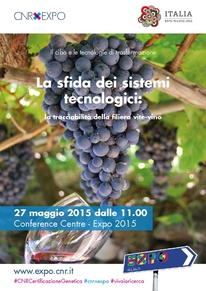The challenge of technology systems: the traceability of wine supply chain

Coordinator: Francesco Carimi
Institute of Biosciences and Bioresources (IBBR)
Interview to Francesco Carimi
What type of event are you planning for EXPO?
The event will begin in a deliberately uncanny manner, with an actor, Giuseppe Gandini and Gianantonio Martinoni, which will perform a parody of the world of wine. The event will be centered on the vine and wine supply chain, contemplated from different perspectives: chemical, genetic, chemical volatile compounds and so on. The starting point is the extraordinary richness of vine varieties, linked to the various parts of Europe. The unique biodiversity of the vine, not typical of all crops, is expressed at the highest level, with a strong link between the vine variety and its various territories. During the event we will have the presence of representatives of industry leaders in technology infrastructure (CISCO), in the management of information stream (Penelope Spa through technology platform ValueGo®), in the development of biotechnology systems applied in the agro-food sector (Bionat Italia Srl) and in wine certification (Valoritalia). We’ve also planned to explain the bases that set down the foundation of these new methodologies we are presenting and we will have a corner used for demonstrating, in real time, how the analyses are performed.
What type of analyses are you performing?
They are analysis that allow you to identify vine varieties and the various substances present in wine. Genetic analyses that involve the DNA analyses. Analyses that work on volatile compounds thanks to an electronic nose. Chemical analyses that allow you to understand the type of land the grapes originate from. Optical analyses from an electronic eye that examine the emission spectra of the wine allowing you to understand the types of compounds present in the wine. This last analysis can help not only to evaluate the quality of the wine but also to understand, on the vineyard, when to harvest the grape, in other words in what stage of maturity the berry is currently in.
What is the genetic analysis of wine?
Firstly, genetic analyses can be performed on both the wine and the vine. Every vine has its own genetic characteristic profile. Each of us all leave traces in our environment of our presence, this is exactly so for the vine, that especially leaves its traces in wine. This is obtained from its juice and contains large amounts of DNA. During fermentation, the juice is transformed and the DNA is degraded, but it remains legible also after it is bottled. With special extraction techniques and analysis it is possible, for example, to understand whether a certain wine was produced or not with the vine variety required by its disciplinary.
What is the purpose of genetic analysis of wine?
They protect honest producers that respect production disciplinary and unveil frauds.
How long does it take to perform an analysis and confirm the actual vines present in the wine product?
They are very quick analyses: most can be performed in minutes. The novelty is that these analyses can be performed in locations other than molecular biology laboratories and can be performed by unskilled personnel. To give you some examples, genetic analyses are concluded in about twenty minutes, the eye and the electronic nose in only a few minutes, thanks to portable devices.
How much will it cost? Are they affordable for producers and wine cellars?
The new method has been developed in partnership with private companies, whose roles have precisely been to make the technologies available and economically viable, because up until today they have been available but only in theory and not in practice. The majority of the costs of the analyses have been tied to technological implications and therefore steadily decreasing in time.
Looking ahead, do you believe these analytical devices will be implemented on a large scale?
From the point of view of the companies in the wine sector, these tools are and will be available at lower and steadily decreasing costs, so I see no obstacles up until honest producers decide for themselves to use them massively. From a political/social point of view it will be the task of politics to find an equilibrium of interest between consumers, who with these tools will find effective systems of safeguard, and the interest of producers and their lobbyist, some of which probably biased, for different reasons, to introduce new controls more or less mandatory.
What are the benefits of implementing them on a large scale?
They are useful in safeguarding Made in Italy. Particularly, genetic testing would be important control instruments, who could also be applied to other products like the oil supply chain, avoiding counterfeits. Such tools provide objective data to assess whether a particular product corresponds or not to its label. The big difference compared to what is done today is that it would no longer be just paper documents to certify that what you are selling corresponds to what is said, but analytical data.







